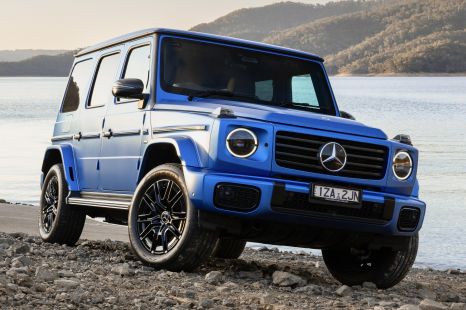

Max Davies
4 Days Ago
T for Touring. The new, more focused Macan variant drives like a baby GTS, which could make it the new pick of the now four-strong line-up.



Quickly see how this car stacks up against its competition. Select any benchmark to see more details.
Take advantage of Australia's BIGGEST new car website to find a great deal on a Porsche Macan.
The first-generation Porsche Macan is turning nine years old in 2023, and shows no sign of slowing down.

Even with a second-gen, all-electric version coming next year, Porsche’s entry-level crossover is expected to carry on for a period time alongside its EV successor; which by that point will be a decade old.
Despite its age, the Macan remains a top-seller for the Porsche brand, and a desirable option in the mid-sized premium SUV segment.
In 2022 the Macan accounted for around 1 in 2 of Porsche’s sales in Australia (2737 units, up 17.6 per cent), even as the company battled crippling supply issues.
Here on test we have arguably the freshest version of the brand’s venerable sports utility, the 2023 Porsche Macan T. introduced just 12 months ago, it’s the first Macan to wear the brand’s ‘T’ for ‘Touring’ badge which dates back to the 911 T of 1968.
Porsche models wearing the ‘T’ badge are said to “offer an especially authentic driving experience thanks to precise tuning, exclusive equipment and efficient engines” – and we’re going to find out if this Macan can do just that.
The Macan T is priced from $92,700 before on-road costs after a recent price increase; though in typical Porsche fashion, there’s a wide range of options that can bump that sticker price well into six figures like our tester.

We’ll get into the nitty gritty of the as-tested extras further down, but the Papaya orange vehicle you see here had just over $25,000 of optional equipment fitted, for a sticker price of $118,560 before on-road costs.
Now, keeping in mind this is effectively a ‘base’ Macan dressed up with some sportier kit and choice extras, that’s asking for similar money to six-cylinder performance versions of most key rivals in the segment.
An Audi SQ5 TDI, which is based on a newer version of the Macan’s VW Group MLB platform, starts at $112,200 with a gruntier 3.0-litre turbo-diesel and a second shaved off its 0-100 time compared to the Macan T; while a BMW X3 M40i has seen a number of recent price increases and currently lists for $125,400 plus on-roads. The sporty Jaguar F-Pace can be had with a 294kW/550Nm turbocharged inline six from as little as $105,700 as well.
Mercedes-AMG hasn’t revealed a new-generation GLC43 as yet, but the outgoing six-cylinder model was priced from $136,000. The new four-cylinder model, powered by a version of the AMG A45’s motor, is expected to see a price jump.
It’s pretty much line-ball with similar high-output four-cylinder alternatives in its base specification, however. The Audi Q5 Sportback 45 TFSI quattro S line is $92,000, and the BMW X3 xDrive30i M Sport is $96,500.

2023 Porsche Macan pricing:
Prices exclude on-road costs
The Macan’s interior has been refined a number of times over the years, but this latest iteration is easily the best yet.

While previous iterations have been quite cluttered and button-heavy, the latest Macan takes inspiration from the brands newest models like the 911, Panamera and Cayenne, and offers a great blend of traditional sports car cabin and new-age technology.
The brand’s new Porsche Communication Management (PCM) infotainment system powers a high-resolution 10.9-inch touchscreen, which offers wireless Apple CarPlay and satellite navigation, as well as the company’s Connect Plus suite of online services.
It has haptic feedback which ‘clicks’ when you tap it, and it’s all quite swish and easy to use with old-school but attractive graphics, and fast responses to inputs. Oddly, however, smartphone mirroring doesn’t take up the entire display to keep a sidebar menu constantly displayed.

Our test car was fitted with the optional BOSE surround sound system ($2230) with 14 loudspeakers including a subwoofer, and an output of 665 watts. To my ears, it offered deep, clear sound that didn’t waver as you dialled up the volume – great for road trip beats.
Like the haptic response touchscreen, the switchgear and controls along the centre console are all haptic touch buttons as well. It looks quite slick and means you don’t have banks of blank buttons, but the glossy black surfacing also means its a magnet for finger prints and smudges.
Some of the buttons are quite small as well, so if you’re trying to press something on the move you might find that you miss or hit the wrong control – small niggle, but worth calling out nonetheless. Like Audi, Porsche has some of the better capacitive switchgear we’ve used.
Overall, build quality feels up there with bank vault status. I’ve driven Macans in the past with some cheaper-feeling trims and components but everything in this latest model feels very well built, and deserving of the price. The additional leather-lined surfaces and pops of (optional) colour are boxes worthy of ticking to uplift the ambience.
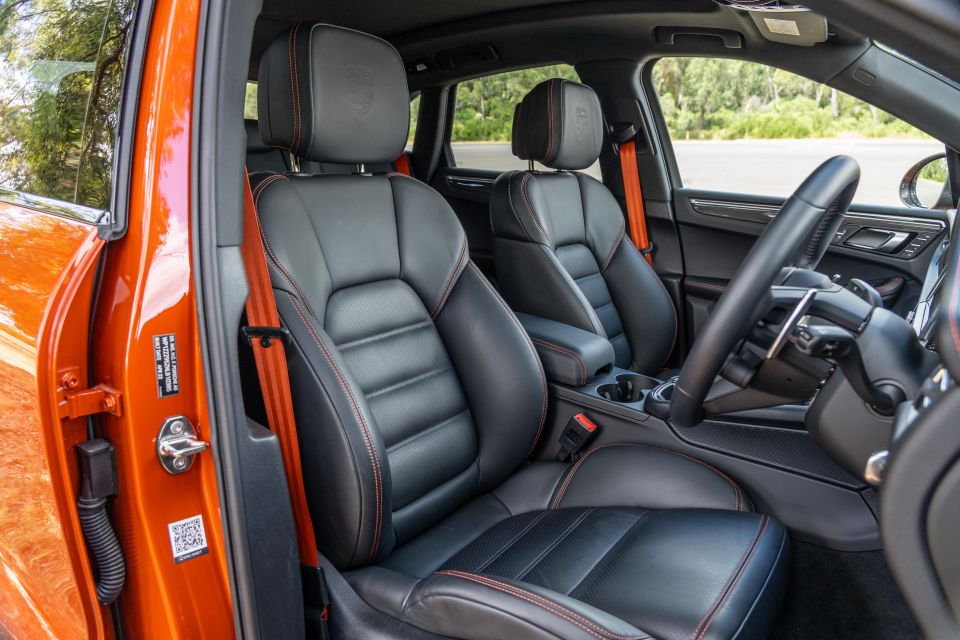

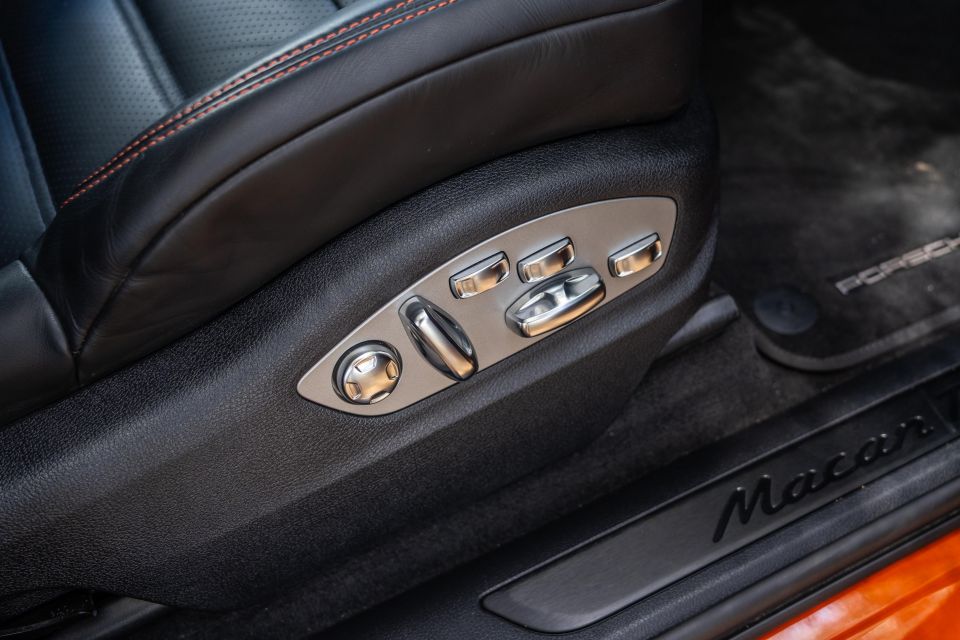
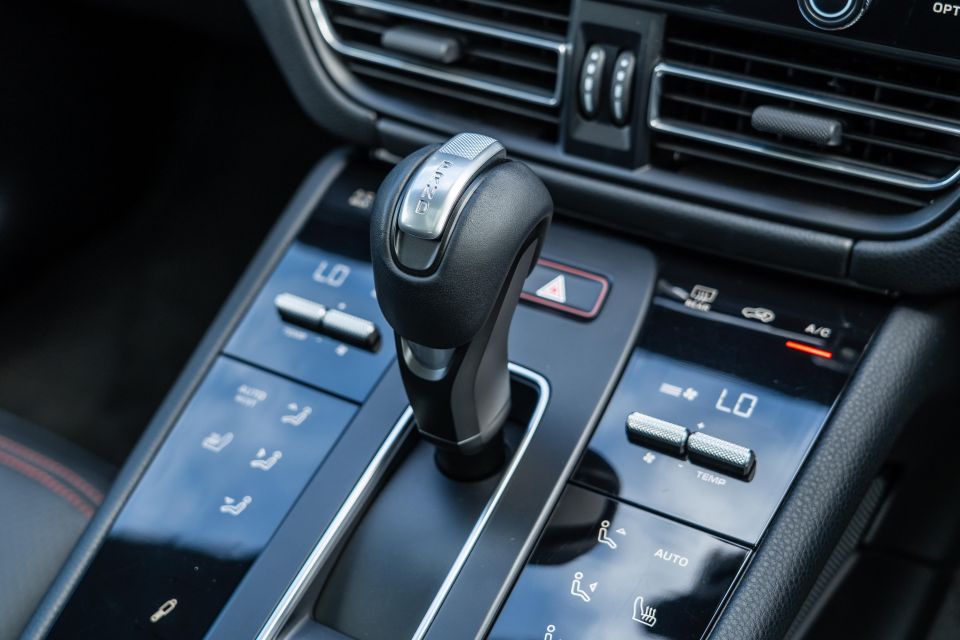
The optional 18-way adaptive sports seats in our test car are beautiful chairs that hold you in and offer plenty of support, with plenty of adjustment to suit your body type and ideal driving position.
While the optional smooth leather package with Papaya orange contrast stitching was a fun up-spec job which is appreciated by a colour-coordinating nerd like me, the standard GTS sports seats that offer eight-way adjustment and leather bolsters with Sport-Tex fabric inserts would perhaps be even more comfortable and summer friendly.
Ahead of the driver is the beautiful Porsche steering wheel, which feels fantastic in the hand. In the past I’ve not been a huge Porsche fan, but everything in the Macan T seemed to suit my tastes.
There’s multifunction controls, a cruise control stalk and a rotary drive mode selector, and it all falls to hand quite nicely and again plays to the brand’s more purist and traditionalist vibe. Fun fact; the heated steering wheel button is hidden behind the bottom spoke – as Paul Maric may have shown you in an Instagram Reel.


Things are a little less impressive in the back, as the Macan is below the segment average for rear passenger accommodation.
It’s on the smaller side of the class for knee and legroom, particularly if you have someone as tall as me (6’1) in the front seat. Kids will be find back there, though, and there’s ISOFIX outboard anchor points as well as top-tether points across all three rear positions as you’d expect.
You’ve also got rear air vents back there with temperature controls, two USB-C charging outlets, a fold-down centre armrest with cup holders, as well as bottle holders in the doors.
Oddly, there are no map pockets behind the front seats, though otherwise it’s well appointed if you disregard the tight passenger room for above-average sized adults. Also worth remembering the Macan’s design is now a decade old.


Four-cylinder Macan models quote boot capacity of 488 litres with the rear seats in place, expanding to 1503L with them folded – 35L more than V6 versions in both measurements.
Again it’s a little down on the segment average, with newer competitors with more space-focused packaging offering bigger boot areas in the 500L realm. The space itself is nice and square, though there’s a bit of a step up from the boot floor to the rear seatbacks when you fold the second row.
For reference, the current Audi Q5 – which rides on a newer MLB Evo platform as opposed to the Macan’s older MLB underpinnings – offers 520 litres of capacity.
Under the boot floor is a temporary space-saver spare wheel.
Powering the base Macan and the Macan T is a 2.0-litre four-cylinder turbocharged petrol engine, a version of the motor used widely across the VW Group – including its hottest hatchbacks.

In the Porsches, the motor is tuned to deliver 195kW and 400Nm (1800-4500rpm), with drive sent to all four wheels via a seven-speed Porsche Doppelkupplung (PDK) dual-clutch automatic transmission with steering paddles.
With its standard Sports Chrono Package (which includes launch control), the Macan T can sprint from 0-100km/h in a Golf GTI-matching 6.2 seconds, on its way to a top speed of 232km/h. Porsche also quotes a 0-160km/h time of 16.1 seconds; and a quarter-mile dash of 14.5 seconds.
Fuel consumption is rated at 9.5 litres per 100km on the combined cycle, with combined CO2 emissions of 217g/km. The fuel tank measures 75 litres across the range, and requires 98 RON premium unleaded.
All versions of the Porsche Macan are rated to tow up to 2000kg (braked).
Some would scoff at the idea of a four-cylinder Porsche – I have in the past, I’ll admit it.

But when I fired up the Macan T for the first time with its optional sports exhaust (a must-tick in my books), it started with a burbly growl that made me double-take and make sure I hadn’t picked up one with a different engine.
It’s no secret the Porsche Macan has long been lauded as one of, if not the driver’s pick in the premium SUV segment, and I’ve had mixed experiences in the past.
The last Macan I tested was the 2020 Macan Turbo which was the first facelift, and while the sonorous bi-turbo V6 shared with the Audi RS4 and RS5 is a peach of an engine, the Macan gave me more GT vibes than high-riding sports car.
I’d argue this latest iteration hasn’t strayed far from that GT feel, but given the T stands for Touring, I guess it’s more fitting.
Having a four-cylinder engine under the bonnet should make you feel like you’ve cheaped out. After all, versions of this 2.0-litre turbo four are used throughout the Volkswagen Group in a number of high-performance applications – including my own Golf GTI.
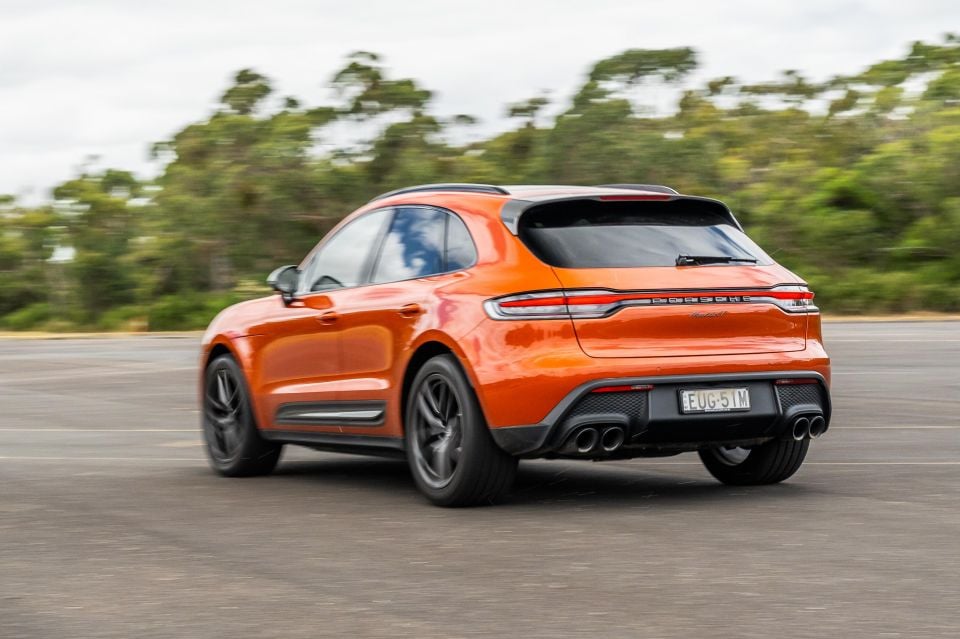
With a healthy 195kW and 400Nm, the Macan T gets along nicely both in town and on the freeway, and with the sports exhaust set to ‘open’ it’s engaging even when you’re just doddling around the ‘burbs. Paul Maric did a VBox run in the video above, and achieved an impressive 5.86s 0-100km/h run – that’s almost 0.4s quicker than the claim.
Our test car was also optioned with adaptive air suspension, something of a rarity in this segment, and with everything set to Comfort and the exhaust set to loud, it’s a great sporty daily that’s also supremely compliant in daily driving.
I absolutely love the steering feel. It’s buttery smooth, direct and has a fairly quick ratio, with enough heft and feedback to not only communicating what’s going on at the front axle but also makes the Macan feel more focused and substantial.
A lot of vehicles in this segment can have quick or variable steering racks but with a very light weight that despite making low-speed manoeuvres easier can really take away from that driver feel and feedback. This was a refreshing departure from that trend.
Dialling it up a little and again the Macan T has all the makings of a fun high-rider, with the same connected feel and punchy performance contributing to a fun drive.

You can give it some beans onto a freeway on-ramp and you’ll be surprised with the low-down shove and meaty mid-range from the turbo four, though you might find it starts to run out of puff as you approach the redline. With Australia’s low speed limits though, you’re never going to feel like this is ‘underpowered’.
I took the Macan T for a blat through some of my favourite roads through Research, Kangaroo Ground and Warrandyte in Melbourne’s north-eastern corridor, and the Porsche took everything in its stride.
Flick the drive mode dial to Sport and Sport+ and the air suspension drops its guts and the dampers firm up. Through some successive bends on winding back roads, the Macan is quite a bit of fun. The bark from the sports exhaust also really helps to make it feel a little more special, with an angry note thats on song right through the mid-range, and some pops on overrun at higher revs.
I will challenge the “jacked-up hot hatch” tag that a lot of journalists have used in the past. At 1865kg unladen in its base specification, the Macan T does feel its weight when you’re really pushing it, though the clever AWD system holds on well and keeps the Macan’s nose in the direction you’re pointing the steering wheel.
That said, the lighter front end compared to six-cylinder models as well as the T’s specific chassis setup definitely makes it feel dartier than previous Macans I’ve tested. It’s like a baby Macan GTS – which is what I feel Porsche was aiming for anyway.

Using the steering-mounted paddle shifters is a delight, and the PDK dual-clutch auto is easily the best in the business. There’s a crispness to the shift speed and response that’s very satisfying, and the sports exhaust likes to pop and bang when you upshift at high revs.
In normal driving there’s none of that jerkiness or low-speed hesitation that dual-clutch autos can suffer from, with the Macan bring a very smooth operator in just about every setting. It’s quite impressive.
Something I noticed on an extended drive to and from my grandparents’s farm in Kilmore (1 hour north of Melbourne) was that the Macan T suffers from a bit of tyre noise intrusion, which took away from its otherwise top-notch refinement. Turning up the optional Bose premium audio system helped, but it did get a bit loud on the Hume.
My touring stint also allowed me to test out the adaptive cruise control and lane-keep assist functions, which all worked as you’d expect and were pretty user-friendly. I understand Porsche’s focus is on the driver actually driving the car, but charging extra for some of these systems ($650 for lane-keep, $1650 for adaptive cruise) seems a bit rude.
You do get standard blind-spot monitoring and lane departure warning though, so it’s not like it has nothing out of the box.



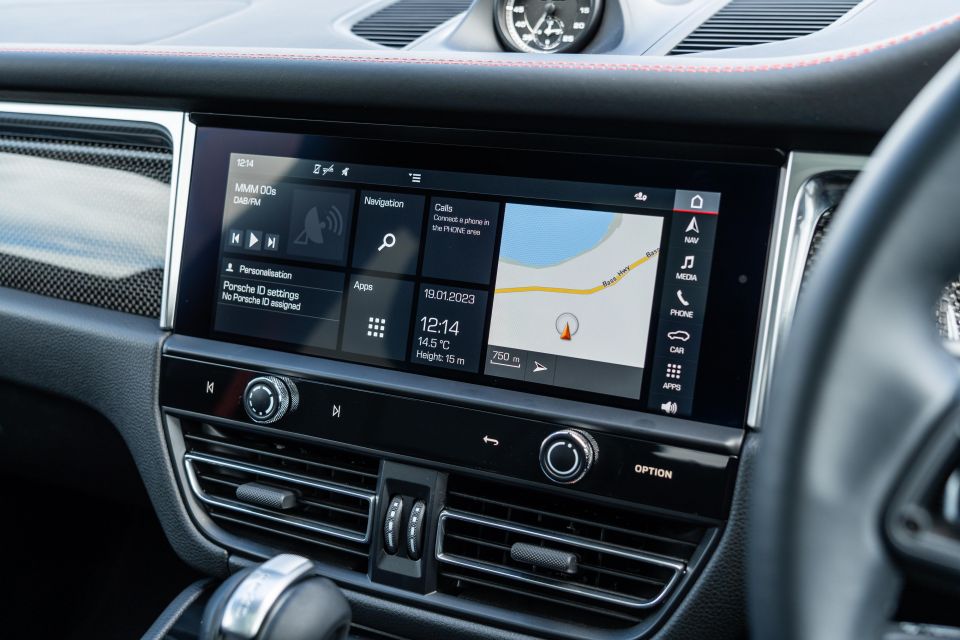
Macan highlights:


Macan T adds:

The Porsche Macan doesn’t wear an ANCAP safety rating, and its five-star Euro NCAP rating from 2014 has expired as of January 2021.

In Euro NCAP testing against much older criteria, the Macan scored 88 per cent for adult occupant protection, 87 per cent for child occupant protection, 60 per cent for pedestrian protection and 66 per cent for safety assist.
Standard safety features include:
Porsche still runs a three-year, unlimited-kilometre warranty which is well behind the pack these days.

Scheduled maintenance is required every 12 months or 15,000 kilometres – whichever comes first.
Unlike most premium brands, Porsche doesn’t offer a capped-price servicing program.
In terms of real-world fuel consumption, the Macan dipped into the eights with more freeway use and then climbed into the tens and elevens with more high-traffic city driving.
Given the combined claim of 9.5L per 100km that’s not bad, but regularly topping up that long-range 75-litre tank with 98 RON isn’t going to be a cheap exercise – especially these days when it’s over 200 cents per litre regularly.
Big call, but I think the Macan T could be the new pick of the range.

Hear me out. It’s $20,000 cheaper than a Macan S, arguably has the best handling balance of the range, and brings the more focused vibe of the top-spec GTS to the more attainable four-cylinder powertrain variant.
It’s quick enough, and with some choice options fitted shapes up as a very well-rounded Porsche utility with a price tag that won’t completely break the bank.
That doesn’t mean it isn’t without its quirks. Apart from its lengthy, and pricey list of options (including assistance systems that should be standard), the tight back seat and small boot are sticking points, and while agile and engaging to drive it can feel a bit heavy when you’re really gunning it like you would a proper Porsche sports car.
All things considered, however, the Porsche Macan is as competitively priced as ever, and continues to be one of the driver picks in the premium mid-size SUV segment. That highly desirable Porsche badge also is a key selling point.

Click the images for the full gallery
MORE: Everything Porsche Macan
Take advantage of Australia's BIGGEST new car website to find a great deal on a Porsche Macan.
James is an automotive journalist based in Melbourne, Australia. Before joining CarExpert.com.au in 2020, James has worked at leading auto media outlets including Carsales and CarAdvice, as well as at Pulse agency for Ford Australia's communications team. In 2019 James made Mumbrella's 'Top 20 most prolific web authors in Australia' list after publishing 1,360 articles between March 1, 2018 and February 28, 2019 for CarAdvice. James is also an Ambassador for Drive Against Depression – an Australian charity whose mission is to support mental wellness through the freedom of driving and a shared love of cars.


Max Davies
4 Days Ago


Max Davies
4 Days Ago


Josh Nevett
3 Days Ago


Matt Campbell
2 Days Ago


Max Davies
2 Days Ago


Angus MacKenzie
1 Day Ago